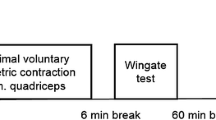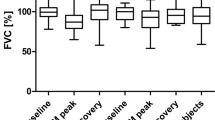Abstract
Exercise is one of the crucial factors responsible for asthma development and exacerbation. The purpose of the present study was to assess the risk of bronchial asthma in female athletes. Spirometric evaluations and physical exercise test were performed and exhaled nitric oxide (eNO) levels were measured in 12 female elite cross-country skiers. Serum concentrations of interleukin 1 beta (IL-1β), tumor necrosis factor-alpha (TNF-α), and interleukin 6 (IL-6) were measured in all subjects before exercise, immediately after it, and after 15 min of recovery. Peak eNO values were 18.7 ± 4.8 (ppb) and did not confirm the risk of early bronchial asthma symptoms. A graded exercise test caused significant increases in TNF-α and IL-1β concentration (p < 0.05) after 15 min of recovery. A significant negative correlation was found between resting and post-exercise eNO and IL-6 levels (p < 0.01). Our study did not confirm an increased risk of bronchial asthma or respiratory tract inflammatory conditions among female cross-country skiers exposed to physical exertion.
Access this chapter
Tax calculation will be finalised at checkout
Purchases are for personal use only
Similar content being viewed by others
References
Alving K, Weitzberg E, Lundberg JM (1993) Increased amount of nitric oxide in exhaled air of asthmatics. Eur Respir J 6(9):1368–1370
Anderson SD, Kippelen P (2012) Assessment and prevention of exercise-induced bronchoconstriction. Br J Sports Med 46:391–396
Berry M, Brightling C, Pavord I, Wardlaw A (2007) TNF-alpha in asthma. Curr Opin Pharmacol 7(3):279–282
Chung KF, Barnes PJ (1999) Cytokines in asthma. Thorax 54(9):825–857
De Gouw HW, Marshall-Partridge SJ, Van Der Veen H, Van Den Aardweg JG, Hiemstra PS, Sterk PJ (2001) Role of nitric oxide in the airway response to exercise in healthy and asthmatic subjects. J Appl Physiol 90:586–592
Dweik RA, Boggs PB, Erzurum SC, Irvin CG, Leigh MW, Lundberg JO, Olin AC, Plummer AL, Taylor DR (2011) An official ATS clinical practice guideline: interpretation of exhaled nitric oxide levels (eNO) for clinical applications. Am J Respir Crit Care Med 184:602–615
Elers J, Pedersen L, Backer V (2011) Asthma in elite athletes. Expert Rev Respir Med 5(3):343–351
Grob NM, Laskowski D, Dweik RA (2008) A technical report on exhaled nitric oxide measurement: asthma monitoring in athletes. J Breath Res 2(3):37027. doi:10.1088/1752-7155/2/3/037027
Haahtela T, Malmberg P, Moreira A (2008) Mechanisms of asthma in Olympic athletes-practical implications. Allergy 63(6):685–694
Kharitonov SA, Yates D, Robbins RA, Logan-Sinclair R, Shinebourne EA, Barnes PJ (1994) Increased nitric oxide in exhaled air of asthmatic patients. Lancet 343:133–135
Kharitonov SA, Yates D, Barnes PJ (1995) Increased nitric oxide in exhaled air of normal human subjects with upper respiratory tract infections. Eur Respir J 8:295–297
Larsen AI, Lindal S, Aukrust P, Toft I, Aarsland T, Dickstein K (2002) Effect of exercise training on skeletal muscle fiber characteristics in men with chronic heart failure. Correlation between skeletal muscle alterations, cytokines and exercise capacity. Int J Cardiol 83(1):25–32
Lim KG, Mottram C (2008) The use of fraction of exhaled nitric oxide in pulmonary practice. Chest 133:1232–1242
Miller MG, Weiler JM, Baker R, Collins J, D’Alonzo G (2005) National Athletic Trainers’ Association position statement: management of asthma in athletes. J Athl Train 40(3):224–245
Parsons JP, Mastronarde JG (2009) Exercise-induced asthma. Curr Opin Pulm Med 15(1):25–28
Pedersen BK, Rohde T, Ostrowski K (1998) Recovery of the immune system after exercise. Acta Physiol Scand 162(3):325–332
Petersen AMW, Pedersen BK (2005) The ant-inflammatory effect of exercise. J Appl Physiol 98(4):1154–1162
Poon AH, Eidelman DH, Martin JG, Laprise C, Hamid Q (2012) Pathogenesis of severe asthma. Clin Exp Allergy 42(5):625–637
Popov TA (2011) Human exhaled breath analysis. Ann Allergy Asthma Immunol 106:451–456
Porsbjerg C, Lund TK, Pedersen L, Backer V (2009) Inflammatory subtypes in asthma are related to airway hyperresponsiveness to mannitol and exhaled NO. J Asthma 46(6):606–612
Renauld JC (2001) New insights into the role of cytokines in asthma. J Clin Pathol 54:577–589
Robbins RA, Barnes PJ, Springall DR, Warren JB, Kwon OJ, Buttery LDK, Wilson AJ, Geller DA, Polak JM (1994) Expression of inducible nitric oxide synthase in human bronchial epithelial cells. Biochem Biophys Res Commun 203:209–218
Rundell KW, Wilber RL, Szmedra L, Jenkinson DM, Mayers LB, Im J (2000) Exercise-induced asthma screening of elite athletes: field versus laboratory exercise challenge. Med Sci Sports Exerc 32(2):309–316
Rundell KW, Anderson SD, Spiering BA, Judelson DA (2004) Field exercise vs. laboratory eucapnic voluntary hyperventilation to identify airway hyperresponsiveness in elite cold weather athletes. Chest 125(3):909–915
Suzuki K, Nakaji S, Yamada M, Totsuka M, Sato K, Sugawara K (2002) Systemic inflammatory response to exhaustive exercise. Cytokine kinetics. Exerc Immunol Rev 8:6–48
Conflicts of Interest
The authors declare no conflicts of interest in relation to this article.
Author information
Authors and Affiliations
Corresponding author
Editor information
Editors and Affiliations
Rights and permissions
Copyright information
© 2014 Springer International Publishing Switzerland
About this chapter
Cite this chapter
Żebrowska, A., Głuchowska, B., Jastrzębski, D., Kochańska-Dziurowicz, A., Stanjek-Cichoracka, A., Pokora, I. (2014). Endurance Training and the Risk of Bronchial Asthma in Female Cross-Country Skiers. In: Pokorski, M. (eds) Body Metabolism and Exercise. Advances in Experimental Medicine and Biology(), vol 840. Springer, Cham. https://doi.org/10.1007/5584_2014_21
Download citation
DOI: https://doi.org/10.1007/5584_2014_21
Published:
Publisher Name: Springer, Cham
Print ISBN: 978-3-319-10249-8
Online ISBN: 978-3-319-10250-4
eBook Packages: Biomedical and Life SciencesBiomedical and Life Sciences (R0)




